CHRYSLER SEBRING COUPE 2004 2.G Owners Manual
Manufacturer: CHRYSLER, Model Year: 2004, Model line: SEBRING COUPE, Model: CHRYSLER SEBRING COUPE 2004 2.GPages: 382, PDF Size: 2.23 MB
Page 91 of 382
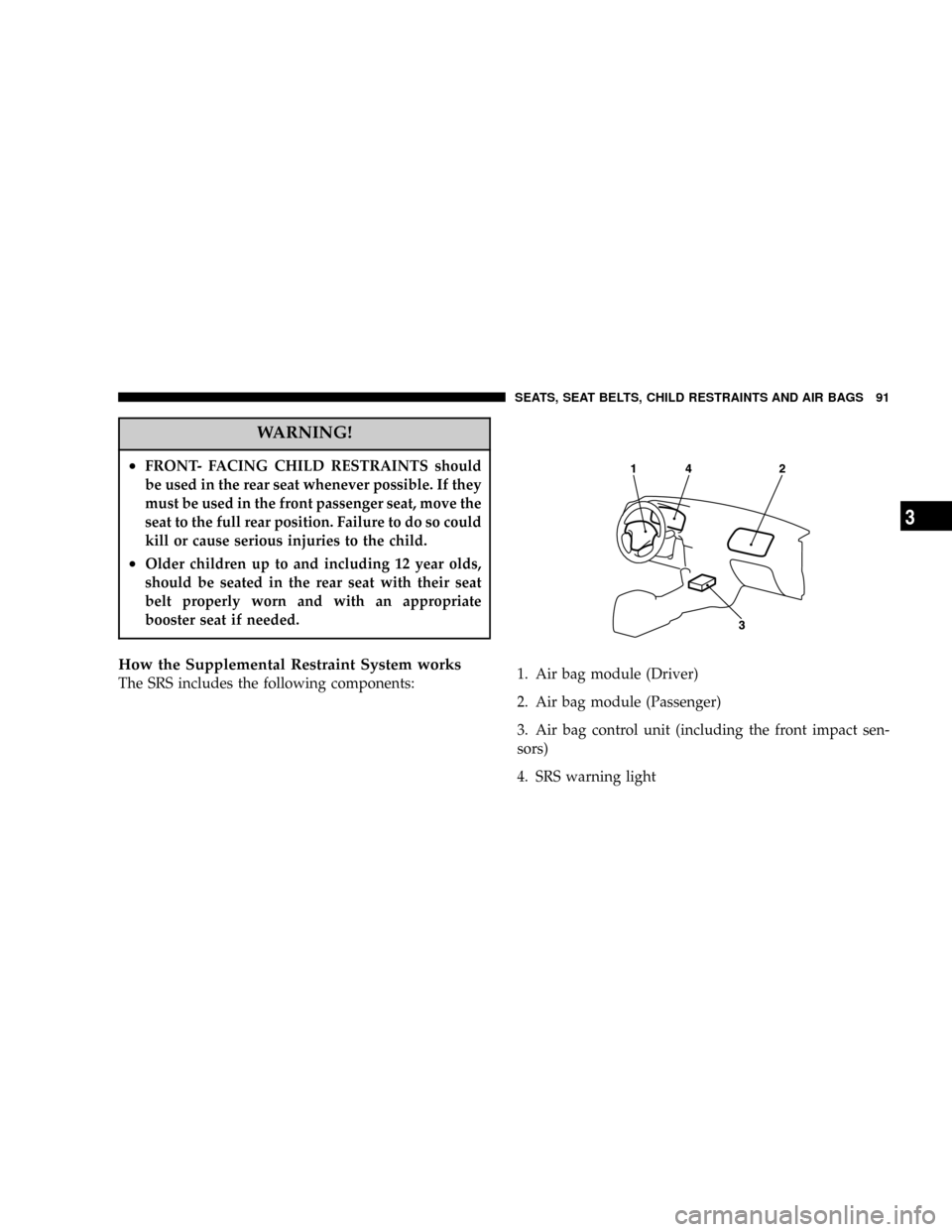
WARNING!
²FRONT- FACING CHILD RESTRAINTS should
be used in the rear seat whenever possible. If they
must be used in the front passenger seat, move the
seat to the full rear position. Failure to do so could
kill or cause serious injuries to the child.
²Older children up to and including 12 year olds,
should be seated in the rear seat with their seat
belt properly worn and with an appropriate
booster seat if needed.
How the Supplemental Restraint System works
The SRS includes the following components:1. Air bag module (Driver)
2. Air bag module (Passenger)
3. Air bag control unit (including the front impact sen-
sors)
4. SRS warning light
SEATS, SEAT BELTS, CHILD RESTRAINTS AND AIR BAGS 91
3
Page 92 of 382
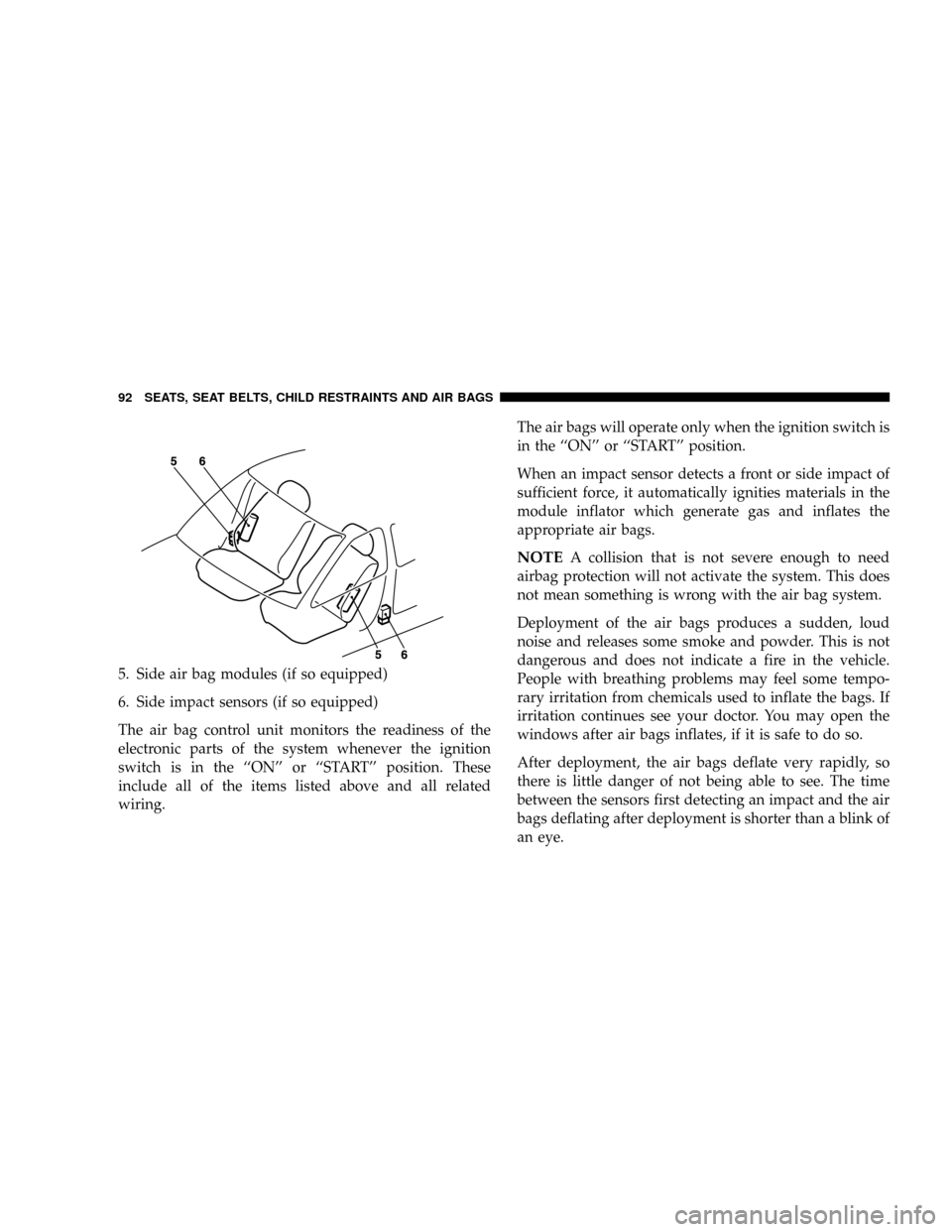
5. Side air bag modules (if so equipped)
6. Side impact sensors (if so equipped)
The air bag control unit monitors the readiness of the
electronic parts of the system whenever the ignition
switch is in the ``ON'' or ``START'' position. These
include all of the items listed above and all related
wiring.The air bags will operate only when the ignition switch is
in the ``ON'' or ``START'' position.
When an impact sensor detects a front or side impact of
sufficient force, it automatically ignities materials in the
module inflator which generate gas and inflates the
appropriate air bags.
NOTEA collision that is not severe enough to need
airbag protection will not activate the system. This does
not mean something is wrong with the air bag system.
Deployment of the air bags produces a sudden, loud
noise and releases some smoke and powder. This is not
dangerous and does not indicate a fire in the vehicle.
People with breathing problems may feel some tempo-
rary irritation from chemicals used to inflate the bags. If
irritation continues see your doctor. You may open the
windows after air bags inflates, if it is safe to do so.
After deployment, the air bags deflate very rapidly, so
there is little danger of not being able to see. The time
between the sensors first detecting an impact and the air
bags deflating after deployment is shorter than a blink of
an eye.
92 SEATS, SEAT BELTS, CHILD RESTRAINTS AND AIR BAGS
Page 93 of 382
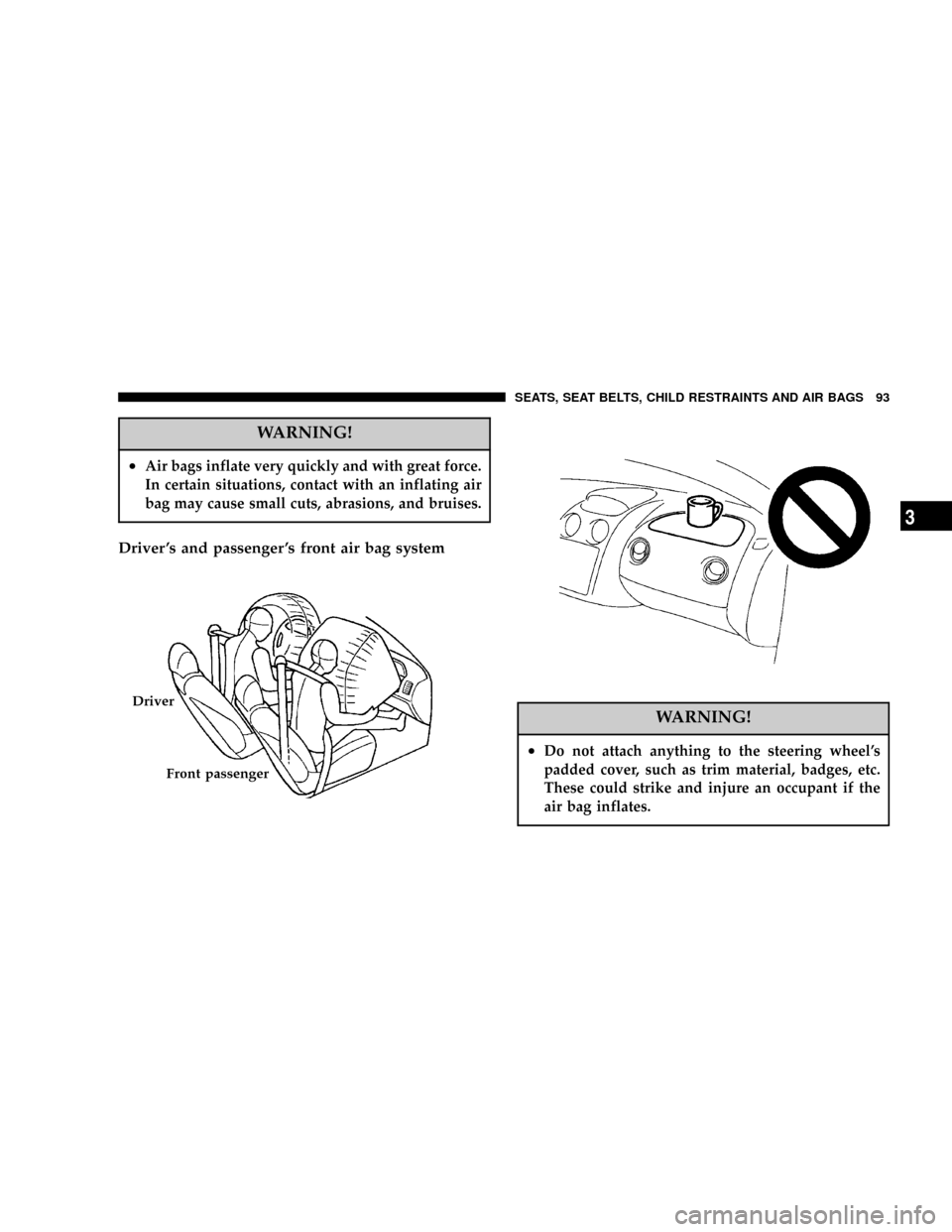
WARNING!
²Air bags inflate very quickly and with great force.
In certain situations, contact with an inflating air
bag may cause small cuts, abrasions, and bruises.
Driver 's and passenger 's front air bag system
WARNING!
²Do not attach anything to the steering wheel's
padded cover, such as trim material, badges, etc.
These could strike and injure an occupant if the
air bag inflates.
Driver
Front passenger
SEATS, SEAT BELTS, CHILD RESTRAINTS AND AIR BAGS 93
3
Page 94 of 382
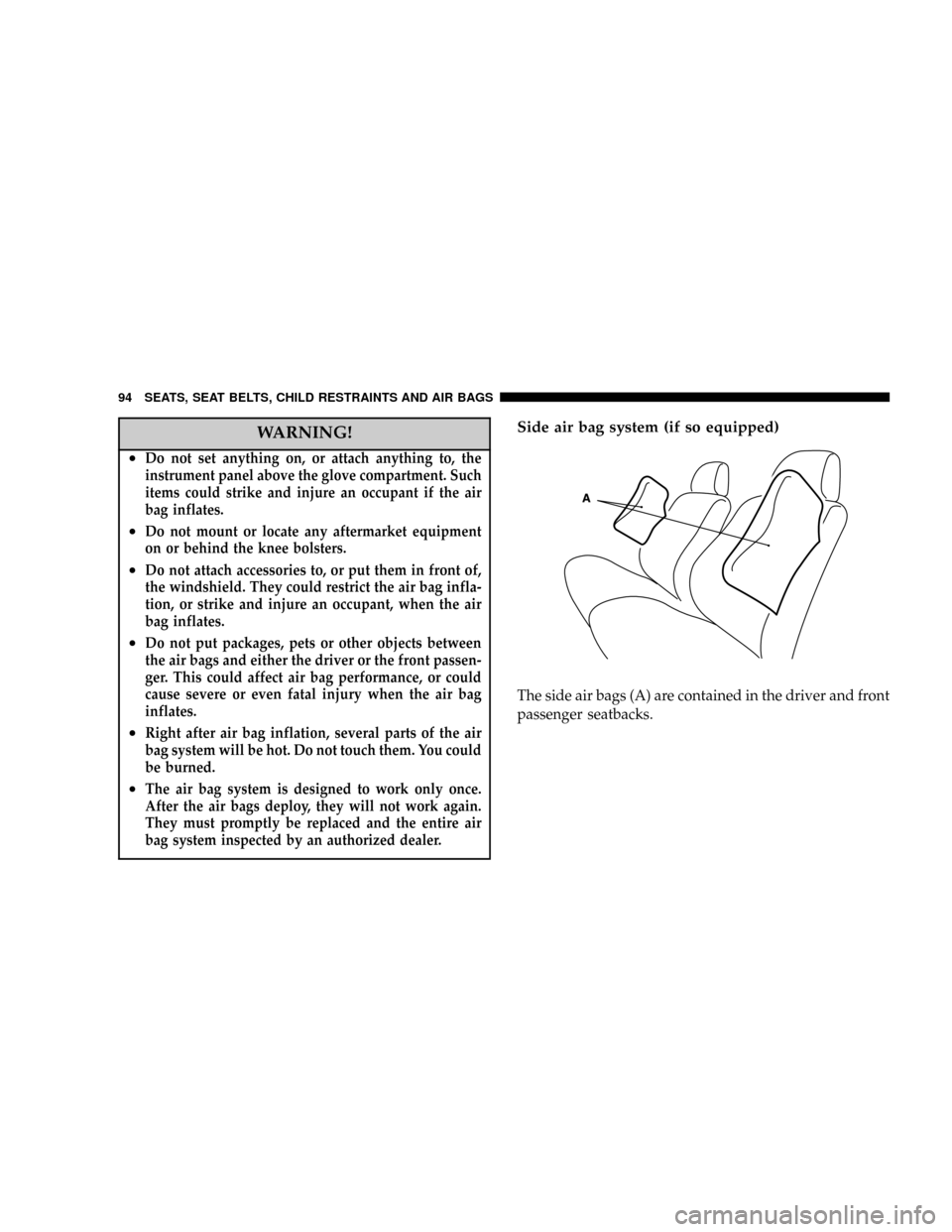
WARNING!
²Do not set anything on, or attach anything to, the
instrument panel above the glove compartment. Such
items could strike and injure an occupant if the air
bag inflates.
²Do not mount or locate any aftermarket equipment
on or behind the knee bolsters.
²Do not attach accessories to, or put them in front of,
the windshield. They could restrict the air bag infla-
tion, or strike and injure an occupant, when the air
bag inflates.
²Do not put packages, pets or other objects between
the air bags and either the driver or the front passen-
ger. This could affect air bag performance, or could
cause severe or even fatal injury when the air bag
inflates.
²Right after air bag inflation, several parts of the air
bag system will be hot. Do not touch them. You could
be burned.
²The air bag system is designed to work only once.
After the air bags deploy, they will not work again.
They must promptly be replaced and the entire air
bag system inspected by an authorized dealer.
Side air bag system (if so equipped)
The side air bags (A) are contained in the driver and front
passenger seatbacks.
94 SEATS, SEAT BELTS, CHILD RESTRAINTS AND AIR BAGS
Page 95 of 382
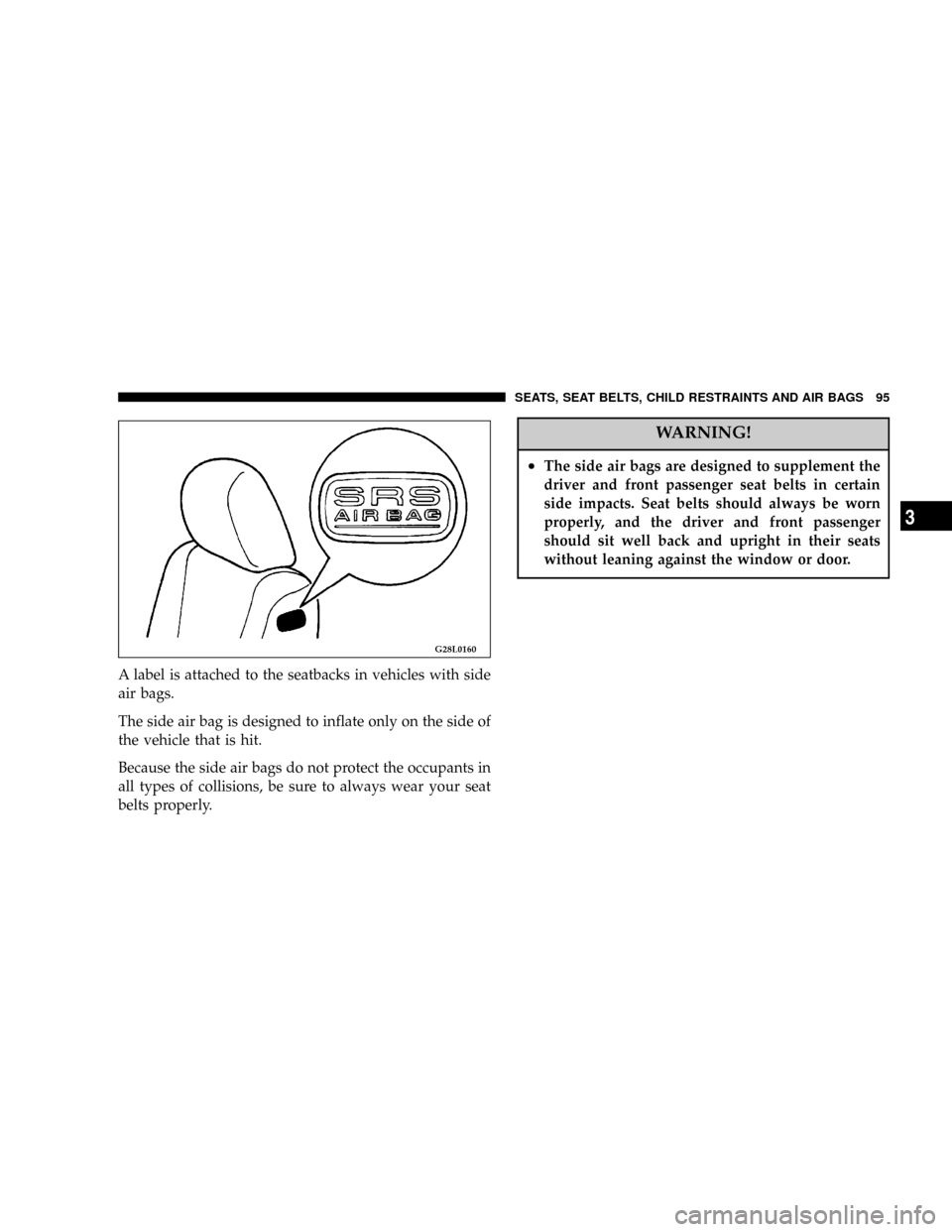
A label is attached to the seatbacks in vehicles with side
air bags.
The side air bag is designed to inflate only on the side of
the vehicle that is hit.
Because the side air bags do not protect the occupants in
all types of collisions, be sure to always wear your seat
belts properly.
WARNING!
²The side air bags are designed to supplement the
driver and front passenger seat belts in certain
side impacts. Seat belts should always be worn
properly, and the driver and front passenger
should sit well back and upright in their seats
without leaning against the window or door.
G28L0160
SEATS, SEAT BELTS, CHILD RESTRAINTS AND AIR BAGS 95
3
Page 96 of 382
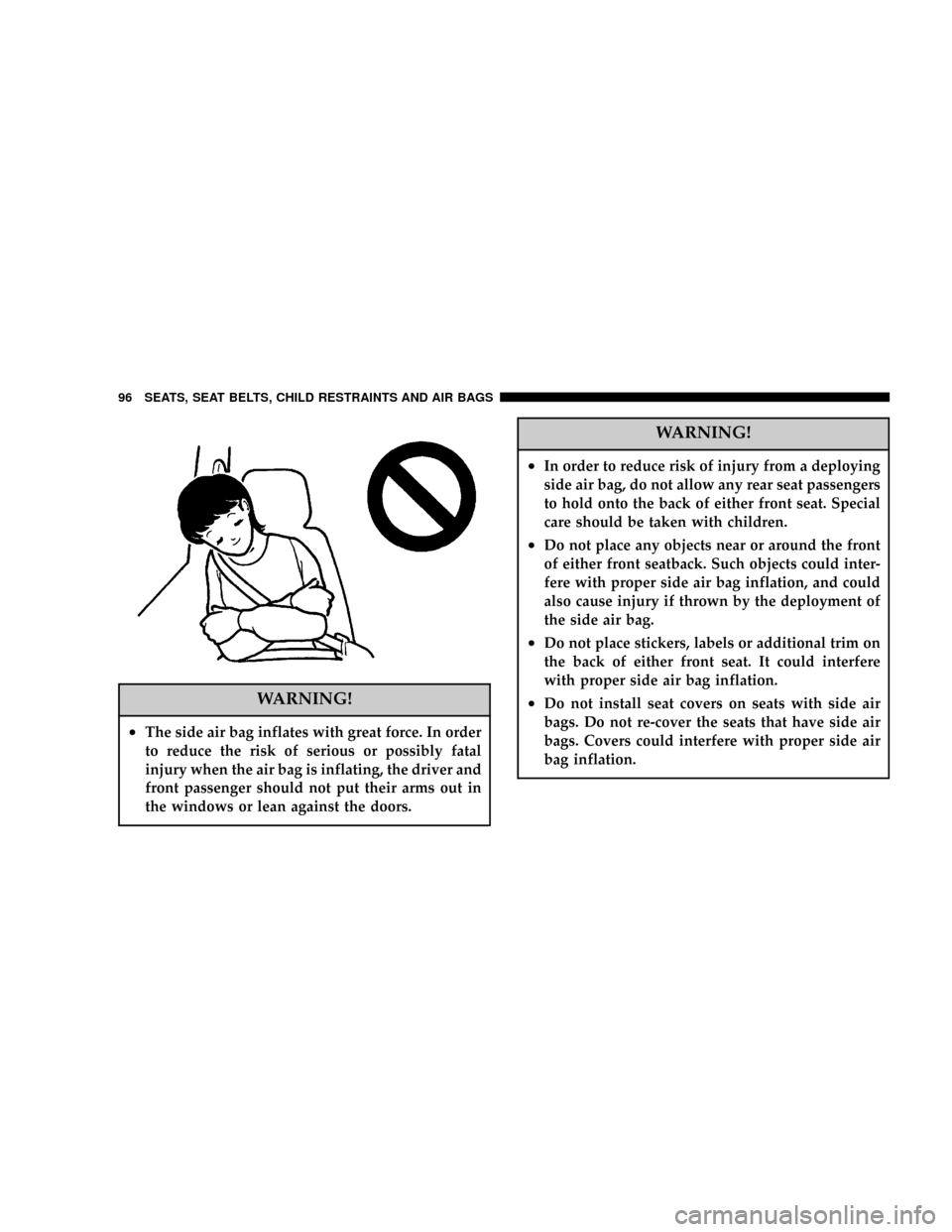
WARNING!
²The side air bag inflates with great force. In order
to reduce the risk of serious or possibly fatal
injury when the air bag is inflating, the driver and
front passenger should not put their arms out in
the windows or lean against the doors.
WARNING!
²In order to reduce risk of injury from a deploying
side air bag, do not allow any rear seat passengers
to hold onto the back of either front seat. Special
care should be taken with children.
²Do not place any objects near or around the front
of either front seatback. Such objects could inter-
fere with proper side air bag inflation, and could
also cause injury if thrown by the deployment of
the side air bag.
²Do not place stickers, labels or additional trim on
the back of either front seat. It could interfere
with proper side air bag inflation.
²Do not install seat covers on seats with side air
bags. Do not re-cover the seats that have side air
bags. Covers could interfere with proper side air
bag inflation.
96 SEATS, SEAT BELTS, CHILD RESTRAINTS AND AIR BAGS
Page 97 of 382
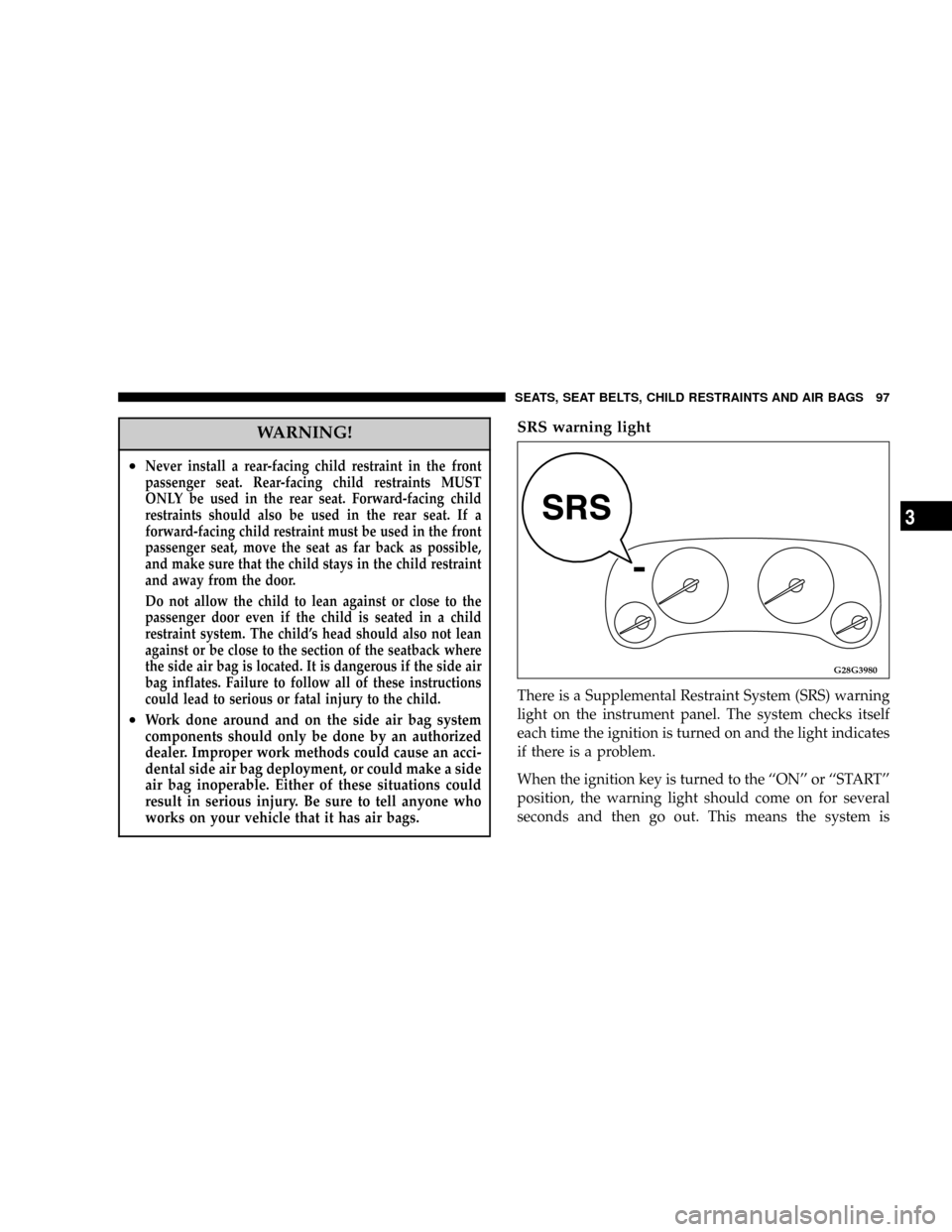
WARNING!
²Never install a rear-facing child restraint in the front
passenger seat. Rear-facing child restraints MUST
ONLY be used in the rear seat. Forward-facing child
restraints should also be used in the rear seat. If a
forward-facing child restraint must be used in the front
passenger seat, move the seat as far back as possible,
and make sure that the child stays in the child restraint
and away from the door.
Do not allow the child to lean against or close to the
passenger door even if the child is seated in a child
restraint system. The child's head should also not lean
against or be close to the section of the seatback where
the side air bag is located. It is dangerous if the side air
bag inflates. Failure to follow all of these instructions
could lead to serious or fatal injury to the child.
²Work done around and on the side air bag system
components should only be done by an authorized
dealer. Improper work methods could cause an acci-
dental side air bag deployment, or could make a side
air bag inoperable. Either of these situations could
result in serious injury. Be sure to tell anyone who
works on your vehicle that it has air bags.
SRS warning light
There is a Supplemental Restraint System (SRS) warning
light on the instrument panel. The system checks itself
each time the ignition is turned on and the light indicates
if there is a problem.
When the ignition key is turned to the ``ON'' or ``START''
position, the warning light should come on for several
seconds and then go out. This means the system is
G28G3980
SEATS, SEAT BELTS, CHILD RESTRAINTS AND AIR BAGS 97
3
Page 98 of 382

working properly. The SRS warning light is shared by the
driver 's air bag, the front passenger 's air bag, and the
optional side air bags.
The air bags will operate only when the ignition switch is
in the ``ON'' or ``START'' position
WARNING!
²If any of the following conditions occur, the SRS
is not working properly and you should immedi-
ately have it inspected by an authorized dealer;
²The SRS warning light does not illuminate
when you start the vehicle.
²The SRS warning light does not go out after
several seconds.
²The SRS warning light comes on while driving.
SRS servicing
The entire SRS must be inspected by an authorized dealer
10 years after the vehicle's manufacture date as shown on
the certification label located on the center pillar of the
vehicle, on the driver's side.
WARNING!
²Any maintenance performed on or near the com-
ponents of the SRS should be performed only by
an authorized dealer. Do not permit anyone else to
do service, inspection, maintenance or repair on
any SRS components or wiring. Similarly, no part
of the SRS should ever be handled, removed or
disposed of by anyone except at an authorized
dealer.
Improper work on the SRS components or wiring
could result in an accidental air bag deployment
or could make the SRS inoperative. Either of these
situation could result in serious injury.
²Do not modify your steering wheel or any other SRS
components or related vehicle part. For example,
replacement of the steering wheel, or modifications
to the front bumper or body structure can negatively
affect SRS performance and may lead to possible
injury.
²If your vehicle has received any front-end dam-
age, you should have the SRS inspected by an
authorized dealer to make sure it is in proper
working order.
98 SEATS, SEAT BELTS, CHILD RESTRAINTS AND AIR BAGS
Page 99 of 382
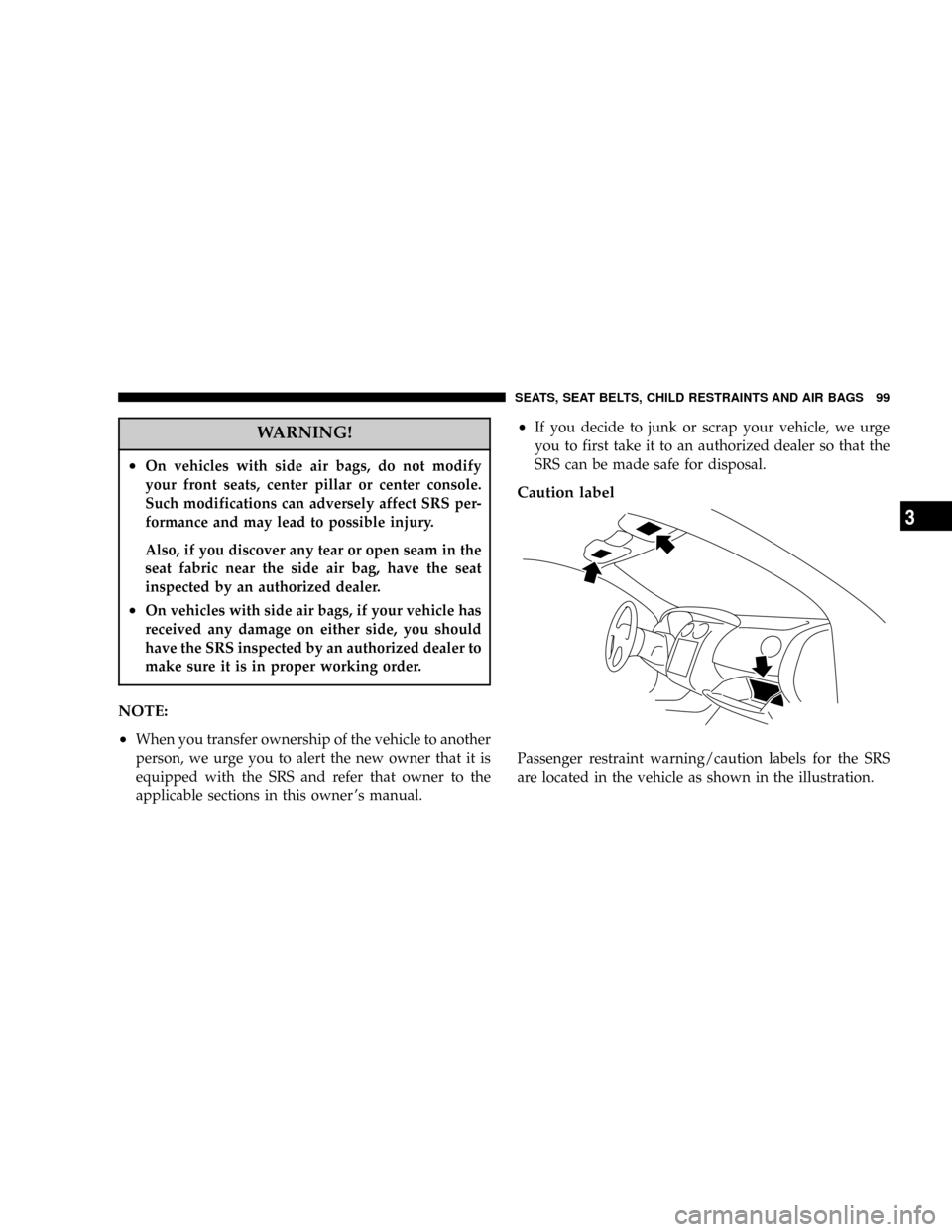
WARNING!
²On vehicles with side air bags, do not modify
your front seats, center pillar or center console.
Such modifications can adversely affect SRS per-
formance and may lead to possible injury.
Also, if you discover any tear or open seam in the
seat fabric near the side air bag, have the seat
inspected by an authorized dealer.
²On vehicles with side air bags, if your vehicle has
received any damage on either side, you should
have the SRS inspected by an authorized dealer to
make sure it is in proper working order.
NOTE:
²
When you transfer ownership of the vehicle to another
person, we urge you to alert the new owner that it is
equipped with the SRS and refer that owner to the
applicable sections in this owner 's manual.
²If you decide to junk or scrap your vehicle, we urge
you to first take it to an authorized dealer so that the
SRS can be made safe for disposal.
Caution label
Passenger restraint warning/caution labels for the SRS
are located in the vehicle as shown in the illustration.
SEATS, SEAT BELTS, CHILD RESTRAINTS AND AIR BAGS 99
3
Page 100 of 382

Transporting Pets
Airbags deploying in the front seat could harm your pet.
An unrestrained pet will be thrown about and possibly
injured, or injure a passenger during panic braking or in
a collision.
Pets should be restrained in the rear seat in pet harnesses
or pet carriers that are secured by seat belts.
100 SEATS, SEAT BELTS, CHILD RESTRAINTS AND AIR BAGS